I recently bought an older Cannondale mountain bike and the rear hub went on it so I started taking it apart and never stopped. Now it's all apart (the entire bike, not just the hub), sanded down to aluminum and I'm thinking that I want it to have a flip flop rear wheel. I primarily ride trails for my health and a little bit off road and a little bit in my hilly little city which brings me to my question(s).
First, I found that when I'm riding distances around 30 miles (or longer), I was very much comfortable riding without stopping using the 42 in the front and the 14 in the back. If one side of my flip flop is fixed, will having a 48 in the front and a 16 in the back be the same as having a 42 in the front and 14 in the back? I'm thinking that it would actually be more efficient if I get into a good cadence. That said, I would like the freewheel side to have 20 or 24 in the back because I'm not all that concerned about going incredibly fast when I'm in the woods unless I'm going downhill. Okay, there's that part of the questioning. Does this make sense? I've never really considered these things until just now.
Second, so that I don't need a chain tensioner, is the Eno Eccentric Hub that keeps popping up online something that I can even do this with? From what I can tell, it seems like it is, but I'd like someone to just say "Yeah, that's totally doable" before I go and spend the money. So what I'm asking is: good idea? bad idea? is there a cheaper idea? any recommendations on whom to go see in person and discuss this with when I'm ready to buy? I hope I'm not coming off as too idiotic. I really am new to this stuff.


 and I've always wondered if BB spindles were symmetrical. From sheldon's site:
and I've always wondered if BB spindles were symmetrical. From sheldon's site: